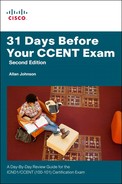Contents
Day 31: Network Devices, Components, and Applications
CCENT 100-101 ICND1 Exam Topics
Network Media Forms and Standards
LAN Device Connection Guidelines
Physical and Logical Topologies
Hierarchy in a Borderless Network
Classification of Network Applications
Growth of Network-Based Applications
The Impact of Voice and Video on the Network
Day 30: Networking Models and Data Flow
CCENT 100-101 ICND1 Exam Topics
Protocol Data Units and Encapsulation
Connection Establishment and Termination
The TCP/IP Network Access Layer
Day 29: Ethernet and Media Access Control
CCENT 100-101 ICND1 Exam Topics
The Role of the Physical Layer
Day 28: Switching Concepts and Operation
CCENT 100-101 ICND1 Exam Topics
Collision and Broadcast Domains
Symmetric and Asymmetric Switching
Accessing and Navigating the Cisco IOS
CLI Navigation and Editing Shortcuts
Storing and Erasing Configuration Files
Day 27: Basic Switch Configuration
CCENT 100-101 ICND1 Exam Topics
Basic Switch Configuration Commands
Half-Duplex, Full-Duplex, and Port Speed
Automatic Medium-Dependent Interface Crossover (auto-MDIX)
Verifying Network Connectivity
CCENT 100-101 ICND1 Exam Topics
Day 25: VLAN and Trunking Configuration
CCENT 100-101 ICND1 Exam Topics
VLAN Configuration and Verification Commands
Configuring and Verifying Trunking
CCENT 100-101 ICND1 Exam Topics
Private and Public IP Addressing
Day 23: IPv4 Subnetting and VLSM
CCENT 100-101 ICND1 Exam Topics
Determine How Many Bits to Borrow
Determine the Subnet Multiplier
List the Subnets, Host Ranges, and Broadcast Addresses
Day 22: IPv6 Addressing Concepts
CCENT 100-101 ICND1 Exam Topics
Day 21: Implementing IPv6 Addressing
CCENT 100-101 ICND1 Exam Topics
Conventions for Writing IPv6 Addresses
Conventions for Writing IPv6 Prefixes
Subnetting into the Interface ID
Stateless Address Autoconfiguration
Day 20: Basic Routing Concepts
CCENT 100-101 ICND1 Exam Topics
Path Determination and Switching Function Example
Classifying Dynamic Routing Protocols
Distance Vector Routing Protocols
Day 19: Dynamic Routing Protocols
CCENT 100-101 ICND1 Exam Topics
Link-State Routing Protocol Features
Calculating the Dijkstra Algorithm
Convergence with Link-State Protocols
Day 18: Basic Router Configuration: IPv4
CCENT 100-101 ICND1 Exam Topics
Basic Router Configuration with IPv4
Day 17: Basic Router Configuration: IPv6
CCENT 100-101 ICND1 Exam Topics
Basic Router Configuration with IPv6
Verifying IPv4 and IPv6 Network Connectivity
Day 16: Static and Default Route Configuration
CCENT 100-101 ICND1 Exam Topics
Static and Default Routing Overview
IPv4 Static Route Configuration
IPv4 Static Routes Using the “Next-Hop” Parameter
IPv4 Static Routes Using the Exit Interface Parameter
IPv4 Default Route Configuration
IPv4 Summary Static Route Configuration
IPv6 Static Route Configuration
IPv6 Default Route Configuration
IPv6 Summary Static Route Configuration
CCENT 100-101 ICND1 Exam Topics
Single-Area OSPFv2 Configuration
CCENT 100-101 ICND1 Exam Topics
Similarities Between OSPFv2 and OSPFv3
Differences Between OSPFv2 and OSPFv3
Single-Area OSPFv3 Configuration
Day 13: Inter-VLAN Routing Configuration
CCENT 100-101 ICND1 Exam Topics
Router on a Stick Configuration and Verification
Multilayer Switch Inter-VLAN Routing Configuration and Verification
Configuring a 2960 to Route Between VLANs
CCENT 100-101 ICND1 Exam Topics
Configuring a Router as a DHCPv4 Server
Configuring a Router to Relay DHCPv4 Requests
Configuring a Router as a DHCPv4 Client
Stateless and Stateful DHCPv6 Operation
Configuring a Router as a Stateless DHCPv6 Server
Configuring a Router as a Stateful DHCPv6 Server
CCENT 100-101 ICND1 Exam Topics
Day 10: Basic ACL Configuration
CCENT 100-101 ICND1 Exam Topics
Configuring Standard Numbered ACLs
Standard Numbered ACL: Permit Specific Network
Standard Numbered ACL: Deny a Specific Host
Standard Numbered ACL: Deny a Specific Subnet
Standard Numbered ACL: Deny Telnet or SSH Access to the Router
Configuring Extended Numbered ACLs
Extended Numbered ACL: Deny FTP from Subnets
Extended Numbered ACL: Deny Only Telnet from Subnet
Standard Named ACL Steps and Syntax
Standard Named ACL: Deny a Single Host from a Given Subnet
Extended Named ACL Steps and Syntax
Adding Comments to Named or Numbered ACLs
CCENT 100-101 ICND1 Exam Topics
CCENT 100-101 ICND1 Exam Topics
Types of Security Vulnerabilities
Passwords, Authentication, Timers, and SSH
Day 7: Switch Security Configuration
CCENT 100-101 ICND1 Exam Topics
Restoring a Port After a Violation
Changing the Native and Management VLANs
Shutting Down and Securing Unused Interfaces
Day 6: Troubleshoot IP Addressing Issues
CCENT 100-101 ICND1 Exam Topics
Resolve IPv4 Address Conflicts
Test Connectivity Using a Static IP Address
Verify Switch Port Configuration
Test DHCPv4 Operation on the Same Subnet or VLAN
Inter-VLAN Routing and IP Addressing Issues
Day 5: Troubleshoot VLAN Issues
CCENT 100-101 ICND1 Exam Topics
Day 4: Troubleshoot Trunking Issues
CCENT 100-101 ICND1 Exam Topics
Trunking Troubleshooting Overview
Check Trunking Operational States
Day 3: Troubleshoot ACL Issues
CCENT 100-101 ICND1 Exam Topics
Problem 1: Host Has No Connectivity
Problem 3: Telnet Is Allowed #1
Problem 4: Telnet Is Allowed #2
Problem 5: Telnet Is Allowed #3
Day 2: Troubleshoot Layer 1 Issues
CCENT 100-101 ICND1 Exam Topics
Interface Status and the Switch Configuration
Common Layer 1 Problems On “Up” Interfaces
Day 1: CCENT Skills Review and Practice
VLANs and Port Assignments Table
IPv4 Addressing Configuration Requirements
HQ-Sw Configuration Requirements
B1 and B2 Configuration Requirements
What You Should Receive After Completion
